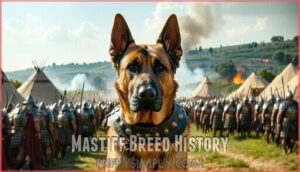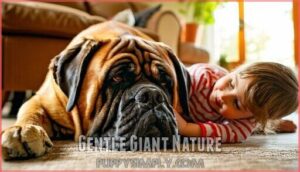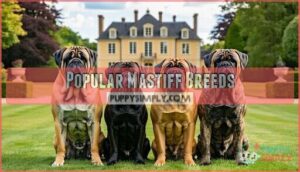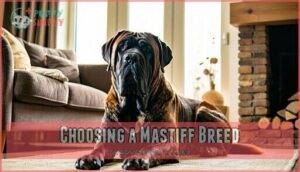This site is supported by our readers. We may earn a commission, at no cost to you, if you purchase through links.
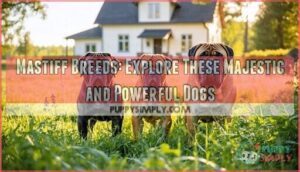 Mastiff breeds are the gentle giants of the dog world, blending power, loyalty, and a calm demeanor.
Mastiff breeds are the gentle giants of the dog world, blending power, loyalty, and a calm demeanor.
These dogs, like the English Mastiff, Bullmastiff, and Tibetan Mastiff, boast ancient roots and were historically guardians and protectors.
Known for their massive size, muscular build, and short coats in various colors, they’re imposing yet surprisingly affectionate.
Mastiffs are fiercely loyal, making them excellent family protectors, though their training needs patience and consistency.
They can face health issues like hip dysplasia, so proper care is key.
If you’re ready for a devoted companion with a big heart, one of these majestic breeds might be perfect.
Table Of Contents
- Key Takeaways
- Mastiff Breed History
- Mastiff Physical Traits
- Mastiff Temperament Types
- Popular Mastiff Breeds
- Mastiff Health Considerations
- Choosing a Mastiff Breed
- Frequently Asked Questions (FAQs)
- What is the friendliest mastiff?
- Are Mastiffs a good family dog?
- What two breeds make a mastiff?
- What is the difference between a mastiff and a Corso?
- How much space do Mastiffs need?
- What is the best way to socialize a Mastiff?
- How long do Mastiffs typically live?
- Are Mastiffs good with other pets?
- Do Mastiffs need a lot of exercise?
- What are common dietary needs for mastiffs?
- Conclusion
Key Takeaways
- Mastiffs are loyal and gentle giants, making them great family dogs with proper training and socialization.
- Their massive size and strength require spacious living areas and moderate daily exercise to keep them healthy and comfortable.
- Regular grooming, wrinkle cleaning (for breeds like Neapolitan Mastiffs), and a balanced diet are essential for their care.
- Each breed, like the English Mastiff or Tibetan Mastiff, has unique traits, so choose one that fits your lifestyle and experience level.
Mastiff Breed History
You’ll find that mastiffs have a history stretching back thousands of years, with roots in ancient civilizations like Egypt and Rome.
These powerful dogs were bred for roles in war, hunting, and guarding, showcasing their strength and loyalty.
Ancient Origins
Mastiffs, one of the oldest ancient breeds, trace their dog breed origins to Egyptian ancestry and Roman war dogs.
Mastiffs, ancient guardians of strength and loyalty, trace their roots to Egyptian ancestry and Roman war dogs.
These ancient dogs, like the Molossus or Molloser, accompanied humans during global migration.
Julius Caesar’s description of their immense strength highlights their role in history.
Breed evolution reflects their adaptability, making them enduring symbols of loyalty and power.
Historical Roles
For centuries, these ancient breeds played pivotal roles in history.
From guarding livestock to battling in gladiator combat, their courage was unmatched.
War dogs like the ancient Molossus accompanied armies, while others protected royal estates.
They even joined humans during ancient migrations, showcasing their loyalty and strength.
- Guarded livestock with vigilance
- Fought alongside soldiers as war dogs
- Protected royalty and estates
- Engaged in gladiator combat
- Accompanied ancient migrations
Medieval Development
In medieval Britain, Mastiffs became indispensable for feudal roles, guarding estates and aiding in hunting practices.
Descended from the ancient Molossus dog, these medieval dogs were prized for their loyalty and strength.
War dogs were often bred to meet emerging breed standards, ensuring their utility in battle and protection, highlighting their unmatched courage and adaptability.
Mastiff Physical Traits
Mastiffs are known for their immense size, muscular build, and commanding presence, with some breeds weighing over 200 pounds.
Their coats come in a variety of colors and textures, adding to their striking and powerful appearance.
Size and Strength
From ancient guardians to modern companions, these massive dog breeds impress with their sheer power.
Mastiff types are known for:
- Weight Comparisons: Some exceed 200 pounds, rivaling adult humans.
- Muscular Development: Built like four-legged tanks.
- Bite Force: Among the strongest of large dog breeds.
- Strength Training: Essential to manage their immense energy.
- Size Advantages: Perfect for protection, their presence alone deters threats.
Coat Colors and Types
From sleek fawn to striking brindle variations, mastiff colors showcase their majestic appeal.
Coat colors range from tawny to black, with markings explained by unique color genetics.
Coat texture varies among mastiff types, from smooth to coarse, influencing shedding frequency.
Whether it’s the Dogue de Bordeaux’s red hue or the Cane Corso’s glossy black, each coat tells a story of elegance.
Muscular Build
In the context of muscular dogs, Mastiff breeds stand out with their sheer muscle mass and bone density.
These massive dogs are built for power and endurance. Imagine this:
- Broad chests and thick limbs built for strength.
- Dense, athletic frames that showcase their raw power.
- Breed differences in size, but all share impressive physicality.
These large dogs are true examples of strength training in nature.
Mastiff Temperament Types
You’ll find that mastiffs are known for their unwavering loyalty and calm, protective nature.
Their temperament combines gentle affection with a natural instinct to guard, making them both endearing companions and reliable protectors.
Loyalty and Protection
Mastiff breeds are natural family protectors, combining loyalty with instinctual protection.
As courageous defenders, their protective instincts shine when guarding loved ones.
These loyal companions form strong bonds, making them ideal guardian breeds.
With their imposing presence and breed affection, they deter threats effortlessly.
Mastiffs thrive in environments where their guardianship is valued, offering unwavering devotion to their families.
Gentle Giant Nature
Mastiff breeds are known as gentle giants, blending their calm temperament with affectionate loyalty.
Gentle giants at heart, Mastiffs combine calm loyalty with protective instincts, making them perfect companions for families seeking affection and security.
These family companions are perfect for those seeking protective yet loving family dogs. Their mastiff temperament shines through in their interactions:
- High affection levels with family.
- Natural gentleness around children, ensuring child safety.
- Composed demeanor in daily life.
- Strong bond-building as affectionate dogs.
They are known for their massive size, often weighing over 120 pounds, which contributes to their reputation as loving family dogs with a calm temperament.
Training Requirements
While their gentle nature shines, a Mastiff’s size and protective instincts mean dog training is non-negotiable.
Early socialization builds trust with strangers and other pets, while positive reinforcement encourages good behavior.
Consistent leadership prevents them from assuming control.
Mental stimulation, like puzzle toys, keeps boredom at bay, and breed differences in Mastiff temperament may require customized approaches, making each training journey unique.
Some owners find electronic training devices helpful for reinforcement, as it can be a valuable tool in the training process, especially when combined with consistent training.
Popular Mastiff Breeds
You’ll find that popular Mastiff breeds like the English Mastiff, Bullmastiff, Neapolitan Mastiff, and Tibetan Mastiff each bring unique traits and histories.
These powerful dogs share a reputation for loyalty, strength, and protective instincts, making them exceptional companions for the right owner.
English Mastiff
Rooted in British origins, the English Mastiff embodies strength and loyalty, tracing back to medieval hunting days.
Known for their massive size and calm temperament traits, they’re protective yet affectionate with families.
Mastiff characteristics demand proper training to manage their power. Modern popularity endures due to their gentle nature, though mastiff puppies require early socialization for balanced behavior.
Bullmastiff
If the English Mastiff impresses you with size, the Bullmastiff adds agility and courage.
Known for loyalty, Bullmastiff temperament blends affection with protective instincts.
Mastiff training should emphasize positive reinforcement to manage their strength.
Regular exercise needs include walks to prevent boredom.
Grooming tips? Their short coat’s low-maintenance.
Watch for common ailments like hip dysplasia in these steadfast guardians.
They’re generally more obedient, unlike the more intense Boerboel.
Neapolitan Mastiff
The Neapolitan Mastiff stands out among Mastiff breeds with its wrinkly skin and imposing jowls.
Known for guarding instincts, these large dogs excel as loyal protectors. However, their size and training challenges require experienced owners.
To care for this breed:
- Clean wrinkles daily to prevent infections.
- Prioritize early socialization.
- Monitor Mastiff health closely.
- Provide consistent, firm training, which is crucial for their development as loyal protectors.
Tibetan Mastiff
From the Neapolitan Mastiff’s wrinkled charm, let’s explore the Tibetan Mastiff, an Ancient Guardian from Central Asia.
Known among giant dog breeds for their Unique Traits, these guard dogs fiercely protect families.
Their Training Challenges mean they’re best for experienced owners.
Despite Breed Popularity growing, Modern Adaptations haven’t softened their bold, independent nature, making them iconic among Mastiff breeds.
Mastiff Health Considerations
Caring for a mastiff means understanding their unique health challenges, like hip dysplasia and skeletal issues.
Each breed has specific needs, so staying informed helps you keep your dog happy and healthy.
Skeletal Issues
Mastiff health isn’t just about size—it’s about structure too.
These gentle giants often face skeletal issues like joint problems and osteoporosis.
Watch for:
- Hip dysplasia, common in large breeds.
- Elbow dysplasia, affecting mobility.
- Osteosarcoma risk, a bone cancer.
- Growth plate injuries, especially in young dogs.
Prevent arthritis with controlled exercise and proper diet for strong joints.
Large breeds can also experience hip and elbow dysplasia, impacting their mobility.
Hip Dysplasia
Hip dysplasia, a common dog health concern in mastiff breeds, stems from a genetic predisposition affecting joint alignment.
Early detection is vital to manage discomfort and prevent severe mastiff health issues.
Weight management and physical therapy can ease symptoms, while surgical options offer long-term solutions.
Prioritizing your dog’s health guarantees they stay active and enjoy life without unnecessary pain.
Breed Specific Health
While hip dysplasia is widespread, each Mastiff breed faces unique health hurdles.
Knowing these helps you plan better care.
- Genetic Predispositions: Tibetan Mastiffs risk epilepsy; Neapolitan Mastiffs often battle skin infections.
- Breed Lifespan: Larger Mastiffs average 7–10 years.
- Preventative Care: Regular vet visits, proper diet, and exercise impact overall dog health and lifespan substantially.
Many owners seek solutions for managing canine dysplasia.
Choosing a Mastiff Breed
When choosing a Mastiff breed, it’s important to match their temperament, size, and care needs with your lifestyle.
Consider factors like family dynamics, exercise requirements, and grooming demands to find the right fit for your home.
Family Suitability
Not every dog breed fits every family, but Mastiffs can be excellent companions if you’ve got the right setup.
Their gentle giant nature makes them great with older kids, though child safety is essential due to their size.
First-time owners might find their temperament concerns challenging, they thrive in spacious homes, requiring early dog socialization to balance their protective instincts.
Exercise Needs
In regards to dog breed exercise needs, Mastiffs require moderate exercise suited to their age.
Puppy exercise should be light to protect growing joints, while adult activity can include short walks or play.
Senior limitations mean slower-paced outings.
Mental stimulation is key for these less active dogs, so consider exercise equipment like puzzle toys to keep them engaged and happy.
You can find various Mastiff enrichment toys online to support their mental stimulation.
Grooming Requirements
Keeping your Mastiff’s coat in top shape means regular coat brushing to manage dog shedding and maintain a healthy dog coat.
Wrinkle cleaning is essential for breeds like Neapolitan Mastiffs to prevent infections.
Nail trimming should be done monthly, and bath frequency depends on activity level.
Proper dog grooming guarantees your majestic companion stays comfortable and clean, enhancing overall dog care. Owners should also be aware of potential health concerns common in the breed.
Best Breed for Owners
Choosing the best Mastiff breed depends on your lifestyle and experience level.
Each breed offers unique dog breed characteristics:
- English Mastiff: Calm, great for families, low maintenance needs.
- Bullmastiff: Loyal, protective, but needs firm training.
- Neapolitan Mastiff: Affectionate, requires experienced owners.
- Tibetan Mastiff: Independent, ideal for seasoned handlers.
- French Mastiff: Gentle, perfect for quieter homes.
Match breed temperament to your home environment!
Frequently Asked Questions (FAQs)
What is the friendliest mastiff?
The Bullmastiff is often considered the friendliest mastiff.
It’s affectionate, loyal, and calm, making it great with families.
While protective, it’s not overly aggressive, blending size and gentleness perfectly when properly trained and socialized to be loyal.
Are Mastiffs a good family dog?
Like a fortress guarding its treasure, Mastiffs are loyal, protective, and gentle with their families.
They’re great for homes with space and older kids, but their size and strength demand training, socialization, and consistent leadership.
What two breeds make a mastiff?
Mastiffs aren’t a single mix of two breeds; they’re a group of ancient dog breeds.
However, some, like the Bullmastiff, result from crossing Bulldogs and Old English Mastiffs for specific traits like guarding.
What is the difference between a mastiff and a Corso?
Think of a Cane Corso as the Mastiff’s athletic cousin.
While both share protective instincts and loyalty, Corsos are leaner, more agile, and require intense socialization.
Mastiffs are larger, calmer, and more laid-back guardians.
How much space do Mastiffs need?
You’ll need ample space for a Mastiff—ideally a large yard or roomy home.
Their massive size makes cramped areas uncomfortable, though they’re not overly active.
Just make certain they’ve space to stretch, roam, and relax comfortably.
What is the best way to socialize a Mastiff?
Imagine introducing your Mastiff to a friendly neighbor’s dog—early, positive interactions like this build trust.
Use treats, praise, and patience to expose them to various people, pets, and environments, ensuring calm and confident behavior.
How long do Mastiffs typically live?
You can expect most Mastiffs to live around 7 to 12 years, depending on the breed and their care.
Their size plays a role in lifespan, so regular vet visits and a healthy lifestyle are key.
Are Mastiffs good with other pets?
Don’t judge a book by its cover," applies here—Mastiffs can get along with other pets if you socialize them early.
Their size might intimidate, but with proper training, they’re gentle giants who coexist peacefully.
Do Mastiffs need a lot of exercise?
Mastiffs don’t need intense exercise, but they thrive on moderate daily activity like walks or playtime.
Overdoing it, especially when young, can harm their joints.
A balanced routine keeps them healthy and prevents boredom, with moderate daily activity being key to their well-being.
What are common dietary needs for mastiffs?
Fuel these gentle giants with high-quality, protein-rich kibble, balancing calories to prevent weight gain.
Add glucosamine-rich foods for joint health, and keep portions measured—overfeeding can weigh them down, literally and figuratively.
Always make certain fresh water is available, as high-quality care demands attention to every detail, including hydration.
Conclusion
Weighing up to 230 pounds, mastiff breeds are among the largest dogs in the world, yet they’re known for their gentle and loyal nature.
These powerful companions offer unmatched protection and affection, making them ideal for families ready to invest in proper training and care.
Whether you prefer the massive English Mastiff or the striking Tibetan Mastiff, each breed has unique traits to suit different lifestyles.
With patience and commitment, a mastiff can become your ultimate devoted friend.

